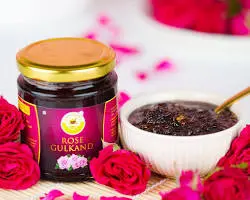In the world of specialty foods, a new star is rising, and it smells like roses. Gulkand, the traditional Indian rose petal preserve, is moving from Ayurvedic pantries to global gourmet shelves. Driven by the worldwide wellness boom and a growing demand for natural, functional foods, this "rose jam" is a golden export opportunity for Indian entrepreneurs.
But how do you take this aromatic delicacy from a local market to a global consumer? This in-depth guide covers the entire export process, from legal setup and documentation to identifying your top international buyers.

Part 1: Why Gulkand? The "Sweet" Opportunity
Gulkand, a blend of rose petals and sugar (or mishri), is far more than just a preserve. Its export potential is built on its powerful health and culinary benefits:
Natural Coolant: It's highly valued for its natural cooling properties, making it popular in hot climates and as a remedy for heat-related ailments.
Digestive Health: It's a celebrated Ayurvedic remedy for acidity, heartburn, and constipation.
Versatile Superfood: The global market is discovering its versatility. It's no longer just a filling for paan (betel leaf). It's now a premium ingredient in:
Gourmet desserts, ice creams, and cheesecakes
Health-focused milkshakes and smoothies
Yogurts and health bars
Artisanal chocolates and sweets
India is the heartland of Gulkand production, giving you a direct source advantage in terms of quality, authenticity, and cost.

Part 2: The A-Z Export Process: Your Step-by-Step Plan
Follow this checklist to build your Gulkand export business from the ground up.
Step 1: Get Your Business Legally Ready
First, create a legal foundation for your export operations.
Register Your Company: Choose a business structure (e.g., Sole Proprietorship, Partnership, LLP, or Private Limited Company) and register it.
Obtain a PAN Card: Get a Permanent Account Number (PAN) from the Income Tax Department for your business entity.
Open a Business Current Account: Open a current account with a bank authorized to deal in foreign exchange.
Step 2: Secure Your Core Export Registrations
These are the non-negotiable licenses for exporting from India.
IEC (Importer-Exporter Code): This is your primary license for international trade. It's a 10-digit code issued by the DGFT (Directorate General of Foreign Trade). You can apply for it online with your PAN.
GST Registration: A GSTIN is mandatory. While exports are "zero-rated" (no GST is charged on the final sale), you need registration to claim refunds (Input Tax Credit) on the GST you paid for raw materials and packaging.
FSSAI Food License: As a food exporter, you must have a Central FSSAI License to ensure your product adheres to national food safety standards.
RCMC from APEDA: Gulkand falls under the category of "Processed Foods." You must obtain a Registration-Cum-Membership Certificate (RCMC) from APEDA (Agricultural and Processed Food Products Export Development Authority). APEDA is the main government body that will support and guide your food export journey.
Step 3: Define Your Product & Quality Standards
Your product's quality is your biggest selling point.
The Right HS Code: The Harmonized System (HS) Code is crucial for customs worldwide. The most common HS code for Gulkand is 21069099 ("Other food preparations, not elsewhere specified or included").
Quality & Lab Testing: International buyers will demand a Certificate of Analysis (COA) from a NABL-accredited lab. This report must verify:
Absence of chemical preservatives or artificial colors.
Low moisture content (to prevent spoilage).
Absence of heavy metals and pesticides.
Value-Added Options (High-Profit!):
Organic Gulkand: Made with certified organic roses and sugar. This commands a premium price, especially in the US and EU.
Mishri Gulkand: Made with rock sugar instead of refined sugar, appealing to highly health-conscious consumers.
Gulkand with Nuts/Spices: Blends with cardamom, nuts, or other herbs.
Step 4: Master Packaging & Labeling
Your packaging must be both attractive and functional.
Primary Packaging: Food-grade glass jars are the standard. They look premium and don't react with the product. Ensure they have airtight, rust-proof lids. For bulk orders, food-grade pails or buckets are used.
Labeling: Your label must comply with the importing country's regulations. It must include:
Product Name ("Rose Petal Preserve" or "Gulkand")
Net Weight
Full Ingredients List
Nutritional Information
Manufacturing and Expiry Dates
FSSAI License Number
Country of Origin ("Product of India")
Vegetarian/Vegan logos (as applicable)
Step 5: Shipping & Logistics

Find a Freight Forwarder: Don't handle shipping alone. A reliable freight forwarder will manage everything from booking container space (sea freight for bulk) or air cargo (for smaller, high-value shipments) to handling all customs paperwork.
Prepare Your Documents: For every shipment, you will need a standard set of documents:
Commercial Invoice cum Packing List
Bill of Lading (for sea) or Airway Bill (for air)
Certificate of Origin
Certificate of Analysis (Lab Report)
Copies of your IEC, GST, FSSAI, and APEDA RCMC.
Part 3: Top Global Buyers & Key Markets
India is the primary exporter of Gulkand, and the demand is concentrated in specific regions. Here’s where to find your buyers.
Top Importing Countries:
United States: The largest market. Buyers include importers of Indian groceries, distributors of Ayurvedic/wellness products, and specialty food retailers catering to health-conscious consumers.
Australia & Canada: Similar to the US, these countries have large South Asian diaspora populations who are familiar with Gulkand. There is also a strong, growing interest in natural and Ayurvedic products among the general population.
United Arab Emirates (UAE) & Middle East: A massive hub for Indian food products. Gulkand is popular here as a cooling delicacy and a gourmet ingredient in sweets and beverages.
Malaysia & Singapore: These countries have a strong tradition of using rose-based syrups and preserves in their cuisine, making Gulkand an easy fit for the market.
Tanzania & Kenya: These East African nations have significant Indian communities, driving a steady demand for traditional food products.
Who Are the "Top Buyers"? (Buyer Profiles)
While specific company names are proprietary, the "top buyers" you should target fall into these categories:
Ethnic Grocery Chains & Distributors: These are your most direct route. They supply thousands of Indian/South Asian supermarkets in the US, Canada, UK, and Australia. They buy in bulk and understand the product.
Wellness & Ayurvedic Portals: Online stores and distributors specializing in "health foods" or "Ayurvedic products" are a perfect match. They will market your Gulkand based on its health benefits.

Specialty Food Importers: These buyers look for unique, gourmet ingredients. They supply high-end restaurants, cafes, and bakeries that might use Gulkand in innovative desserts.
B2B Paan & Sweet Manufacturers: Large-scale manufacturers of Indian sweets (mithai) or paan mixes based in other countries are major bulk buyers.
How to Find Them:
B2B Portals: Create a stellar profile on platforms like Alibaba, IndiaMART, and Global Sources.
APEDA: APEDA regularly organizes Buyer-Seller Meets and lists directories of certified importers.
International Trade Shows: Attending (or exhibiting at) food expos like Gulfood (Dubai) or Biofach (for organic products) can connect you directly with major international buyers.
Final Verdict
Exporting Gulkand is a journey into a niche but rapidly growing global market. It requires a strong focus on quality, adherence to food safety standards, and professional branding. By positioning your Gulkand as a premium, healthy, and versatile product, you can turn this fragrant Indian tradition into a highly profitable international success.